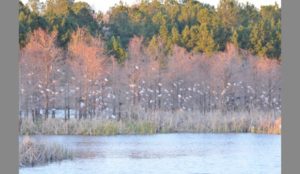Savannah/Hilton Head International Airport studies wood storks with eye toward relocation
Mary Landers
Savannah Morning News
May 7, 2017-Updated May 8, 2017
mary.landers@savannahnow.com

The Savannah/Hilton Head International Airport is gearing up to study a different sort of flyer — a big gawky bird called a wood stork.
About 100 of these birds, which are listed as threatened under the Endangered Species Act, have established a rookery at the airport. At 3 feet tall with a 6-foot wingspan, wood storks pose a danger to air traffic.
“We have had one incident of a bird strike involving a wood stork on a corporate jet that caused damage to the aircraft,” Lori Lynah, airport marketing director, wrote in an email. “It occurred when the aircraft was approximately five miles away from the airport, on arrival.”
It was an even worse outcome for the bird, noted Larry Bryan, research associate at the University of Georgia’s Savannah River Ecology Laboratory, who will be conducting the study.
“The stork lost that one,” Bryan said.
In preparing to address this safety issue and possibly encouraging the colony to relocate by draining its pond or removing the cypress trees where the birds nest, Bryan will be attaching GPS transmitters to four of the wood storks to track their daily and seasonal movements.
“One of the biological questions is if you remove the colony, where do they go?” Bryan said.
The Savannah City Council recently approved $49,280 of funding for Bryan to study the storks.
He plans to use decoys to attract the wood storks, then net them and attach the transmitter with a backpack-like harness.
The intent of the study will be to better understand the storks’ fidelity to their breeding site and movement among other potential breeding sites, Lynah said.
“This is important because one potential action to mitigate the safety hazard would be to modify the colony site and render it unsuitable for future stork nesting,” she said. “The study would assess the impact of breeding site loss on parent wood storks by documenting their movements before, during and after colony site modification, and for several years after the colony site modification. Information from this study could be useful in the management of the species towards recovery.”
Bryan, who’s been studying wood storks since 1984, said they’re “almost an archaic bird.” With bald heads they look like their cousins the vultures, but they’re actually one of just two species of true storks in North America and the only one that breeds north of Mexico. They can’t spear fish like other wading birds and instead poke around in the mud with their beaks feeling for prey.
When the first commercial flights began opearating out of what was then Travis Field in 1950, wood storks were less common in Georgia. The birds have moved north from their more traditional concentration around the Florida Everglades as those wetlands have been compromised.
“Now more than half the population is above the Georgia/Florida line,” Bryan said. And that population is growing. Wood storks were upgraded from endangered to threatened status in 2014.
As a public use airport, Savannah’s operating agreement with the Federal Aviation Administration includes a wildlife hazard management plan.
“The FAA recommends correcting any wildlife hazards, and the biological assessment provided by the study will be used to determine the most suitable methods to minimize the hazard,” Lynah wrote. “Since the birds causing the hazard are currently a threatened species, the FAA and the Airport will work with the U.S. Fish and Wildlife Service to comply with conditions of any proposed actions.”
